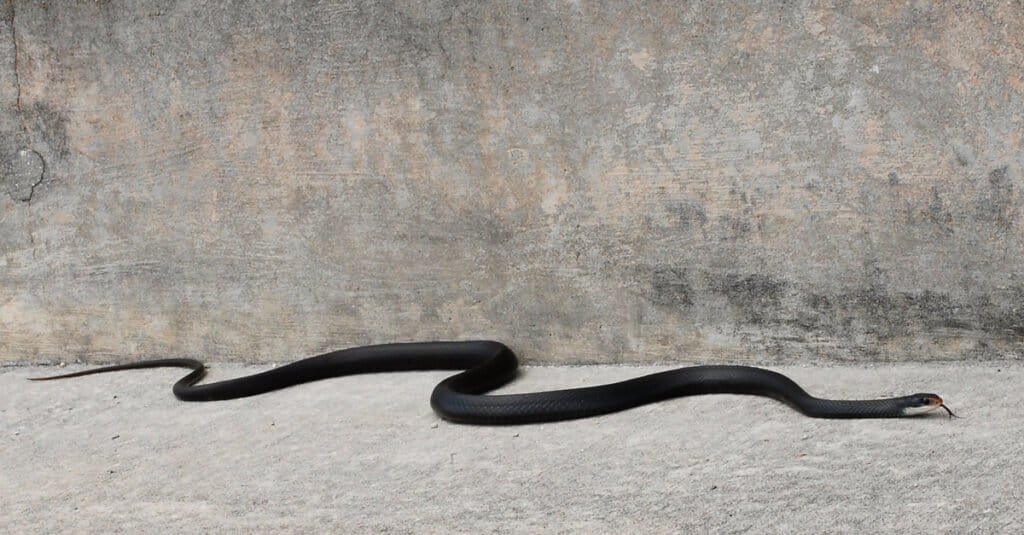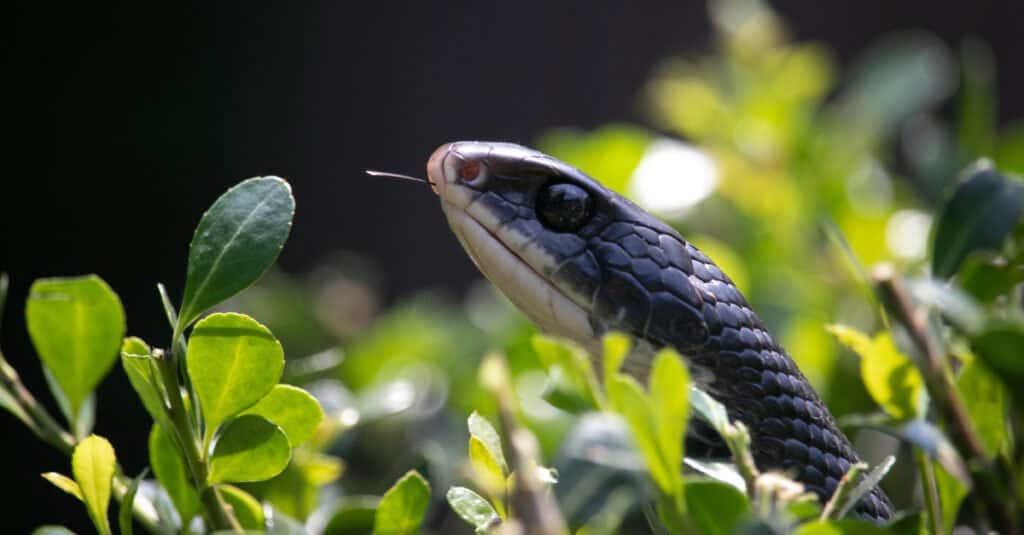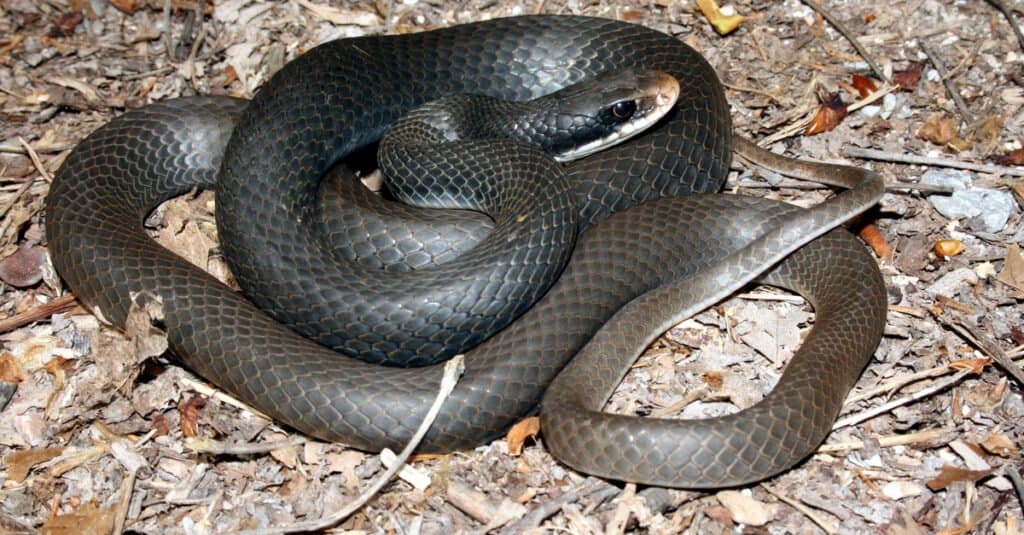Southern Black Racer
.jumbotron {
background-image: url(“https://a-z-animals.com/media/2022/02/southern-black-racer-4-400×300.jpg”);
}
}
@media only screen and (min-width: 641px) and (max-width: 920px) {
.jumbotron {
background-image: url(“https://a-z-animals.com/media/2022/02/southern-black-racer-4-470×370.jpg”);
}
}
@media only screen and (min-width: 921px) {
.jumbotron {
background-image: url(“https://a-z-animals.com/media/2022/02/southern-black-racer-4.jpg”);
}
}
Southern Black Racer
Coluber constrictor
These snakes live underground, beneath piles of leaf litter or in thickets, and they are expert swimmers.
Southern Black Racer Scientific Classification
- Kingdom
- Animalia
- Phylum
- Chordata
- Class
- Reptilia
- Order
- Squamata
- Family
- Colubridae
- Genus
- Coluber
- Scientific Name
- Coluber constrictor
Read our Complete Guide to Classification of Animals.
Southern Black Racer Conservation Status
Southern Black Racer Facts
This post may contain affiliate links to our partners like Chewy, Amazon, and others. Purchasing through these helps us further the A-Z Animals mission to educate about the world’s species..

Discover alligator-eating snakes, spiders larger than your phone, and 1000 more incredible animals in our daily FREE email.
.photo-gallery {
–margin: 0px auto 0px;
–padding: 0px 0px 0px 0px;
}
.gallery-link {
background-image: url(“https://a-z-animals.com/media/2022/02/Southern-Black-Racer-1-1024×535.jpg”);
background-repeat: no-repeat;
background-size: cover;
background-position: center;
height: 500px;
justify-content: center;
text-align: center;
align-items: center;
display: flex;
border: 2px solid #000;
}
.gallery-link img {
height: 50%;
}
@media only screen and (max-width: 768px) {
.gallery-link {
height: 300px !important;
}
}
View all of the Southern Black Racer images!
“The southern black racer spends the winter in dens with many other types of snakes.”
The southern black racer lives in the United States and Mexico. This snake is not venomous but uses its great speed to escape predators and other threats. Though it’s known as a constrictor, it doesn’t kill its prey like other constrictor snakes like boa constrictors. They are carnivores eating rodents, birds, bird eggs, and lizards. This snake has a habit of lifting its head and long neck several inches off the ground to scout out its surroundings.
4 Southern Black Racer Amazing Facts
- A female can lay up to 23 eggs in one clutch
- These reptiles can swim, climb trees and move across the ground at a very fast rate of speed
- Baby black racers have gray or brown scales with a red splotch pattern for the first year of life
- This is a shy, skittish snake that moves away when it feels threatened
Where to Find Southern Black Racer
The southern black racer is sometimes called the North American black racer. These snakes live in the southeastern section of the United States including Florida, Georgia, Tennessee, Alabama, Louisiana, and South Carolina. However, the territory of this snake isn’t restricted to the southeast. It also lives in northern areas of the United States including the states of Maine and Minnesota. They also live in Mexico in Belize and Guatemala.
button.pulse {
transform: scale(1); animation: pulse 2s infinite;
box-shadow: 0 0 0 0 rgba(11, 247, 25, 1);
}
@keyframes pulse {
0% { transform: scale(0.90); box-shadow: 0 0 0 0 rgba(11, 247, 25, 0.5); }
60% { transform: scale(1); box-shadow: 0 0 0 15px rgba(11, 247, 25, 0); }
100% { transform: scale(0.90); box-shadow: 0 0 0 0 rgba(11, 247, 25, 0); }
}
Southern black racers live in a prairie habitat as well as in scrubs, pinelands, sandy areas and even venture into the backyards of homes in the suburbs.
Specifically, these snakes live underground, beneath piles of leaf litter or in thickets. They are usually found near water. These reptiles are expert swimmers.
The cold weather months are spent in brumation. In the month of October, the snakes go underground into dens containing other species of snakes. The entrance to this type of den may be located on a hillside or between two rocks in a pineland. They emerge in March and are especially active during the spring breeding season.
Types of Racer Snakes
Southern black racers are members of the Colubridae family. This is the largest family of snakes. Within that family, there are several species of racer snake. These include:
- Buttermilk racer (Coluber constrictor anthicus)-This snake inhabits the southern area of the United States namely eastern Texas, Louisiana and Arkansas. Like other racers, they are not venomous and are 30 to 60 inches in length.
- Tan racer (Coluber constrictor etheridgei)-The territory of this snake overlaps the territory of the southern black racer. The tan racer snake is found in the southern part of the United States in Texas and Louisiana. Adults reach a length of 30 to 60 inches.
- Blue racer (Coluber constrictor foxii)-These snakes live in the United States in the states of Michigan and Wisconsin as well as in Illinois, Iowa, Minnesota, and Indiana. They are known for the bluish-gray scales. At four to six feet in size, they are about the same length as southern black racers.
- Everglades racer (Coluber constrictor paludicola)-This snake earned its name because it’s found in the Everglades in Florida as well as in other areas within the state. These snakes usually grow to a length of four and a half feet.
Southern Black Racer Scientific Name
Coluber constrictor is the scientific name of the southern black racer snake. The Latin word Colubridae means serpent and constrictor points to the way this snake kills its prey. Its other name, North American racer, is more descriptive because this snake lives in areas other than the south. It is in the Colubridae family and the class Reptilia.
Its subspecies include:
- Coluber constrictor anthicus
- Coluber constrictor etheridgei
- Coluber constrictor foxii
- Coluber constrictor paludicola
Southern Black Racer Population and Conservation Status
The population estimate for this snake is 1,000,000 mature adults and likely more. Its numbers are considered stable. The IUCN Red List has this reptile categorized as Least Concern.
How to Identify a Southern Black Racer: Appearance and Description
An adult southern black racer snake has solid black scales on its upper body along with a white chin. It has round pupils, a slender, thin body, and its scales are smooth. The total length of this snake can be two to five feet, but some of these racers are six feet.
As a note, a baby southern black racer measures just six inches upon hatching. Look at a baby southern black racer and an adult. Their coloration makes them look like two different species of snake. The coloring and patterns of baby racers allows them to blend in with their pineland or scrub environment. As they age, they quickly take on the solid black scales and white chin of an adult.
How to identify a southern black racer:
- Mostly solid black scales with a white chin
- A slender body and head with smooth scales
- Round pupils
- Tremendous speed
Discover the largest black racer snake ever recorded.
Southern Black Racer Pictures

Perry Correll/Shutterstock.com

TjacksonVii/Shutterstock.com

Psychotic Nature/Shutterstock.com
Southern Black Racer: How Dangerous Are They?
Southern black racers are not venomous snakes. They are shy and use their great speed to escape humans, animal predators or any other threat. But, like most snakes, if a southern black racer is cornered or feels it has no escape from a situation, it is able to inflict a painful bite.
If a person gets a bite from a North American racer, then it’s important to wash the injured area with soap and warm water. Cleaning the area cuts down on the chance it will become infected. This snake’s bite is known to be painful so putting an ice pack on the injured area can relieve the pain. If the area doesn’t begin to heal in a few days or it becomes red or develops a rash, it’s a good move to visit a doctor about it.
Southern Black Racer Behavior and Humans
Southern black racers are active in the daytime. They are out hunting for mice, birds, lizards, and bird eggs. They are very plentiful in certain states including Florida and Louisiana. These reptiles are useful in keeping rodent populations from becoming unmanageable. So, if this snake is seen on a farm or another piece of property, it should not be considered a pest.
It’s not unusual to see this snake moving around in a suburban, wooded backyard or crossing a street bordered by fields or woods. If they are spotted by a human, they try to get away as quickly as possible. Unfortunately, these snakes are often run over and killed by cars and trucks. They are fast but not always able to get out of the way of passing traffic.
View all 186 animals that start with S
Southern Black Racer FAQs (Frequently Asked Questions)
What’s the difference between cottonmouths and black racers?
The main difference between black racers and cottonmouths is that black racers are non-venomous while cottonmouths have venom. In addition, cottonmouths have a wider body and are found in more aquatic habitats.
Are southern black racers venomous?
No, these snakes are not venomous.
Are southern black racers aggressive?
No, these snakes are the opposite of aggressive. They are timid and won’t lash out unless they feel cornered.
How do southern black racers hunt?
They hide in brush or a thicket waiting for birds, lizards, or rodents to enter the area. Once they go after their prey, they use their speed to capture the animal. This is where there’s a little confusion regarding the name of this snake.
It’s known as a Coluber constrictor. Most people picture a constrictor snake killing its prey by wrapping around it and squeezing it to death. Alternatively, a southern black racer grabs its prey with its strong jaws. Then, it pushes its prey against the ground to suffocate it. This reptile swallows its dead prey whole.
Where do southern black racers live?
They live in the southeastern United States and as far north as Maine and Minnesota. In addition, they are found in Mexico.
What do southern black racers eat?
Mice, rats, lizards, birds, tree frogs, and bird eggs are all prey of this snake.
Will a black racer snake chase you?
No. If this snake sees you, it moves in the opposite direction.
How big does a southern black racer get?
The typical length of this snake is two to five feet, but they can grow as long as six feet.
Do black racers bite humans?
Yes, they are able to bite humans when they feel no other way to escape a situation.
What’s the difference between a black racer and a black rat snake?
The main differences between a black racer and a black rat snake are their markings and sizes. Black rat snakes are larger than black racers, and black racers prefer to run away while black rat snakes hold their ground.
What’s the difference between a black racer and a copperhead?
Black racers are longer than copperheads, but copperheads are far heavier. In terms of coloring, copperheads have a unique tan color with brown hourglass markings, while black racers are almost solid black. Black racers are non-venomous, but copperheads are pit vipers and come equipped with potent venom.
What is the difference between an Indigo snake and a black racer?
The major difference is that Black racers weigh only 1-2 pounds, while indigo snakes weigh between 4-10 pounds. Indigo snakes can be found only in the southeastern United States, in Florida, Georgia, Alabama, and Mississippi. Black racers also live in the southeastern part of the United States, but they can be found as far north as southern Maine, and far west as eastern Texas.
Sources
- , Available here: https://ufwildlife.ifas.ufl.edu/snakes/blackracer.shtml
- , Available here: http://www.kingsnake.com/louisiana/species_buttermilk_racer.htm
- , Available here: https://www.projectnoah.org/spottings/10117532
- , Available here: https://www.iucnredlist.org/species/63748/3128579
- , Available here: https://en.wikipedia.org/wiki/Southern_black_racer
- , Available here: https://sccf.org/walking-trails/southern-black-racer
- , Available here: https://sciencetrends.com/southern-black-racer-snake-facts-and-photos/
















